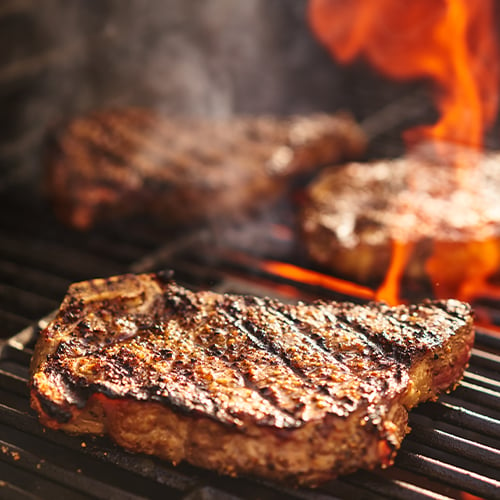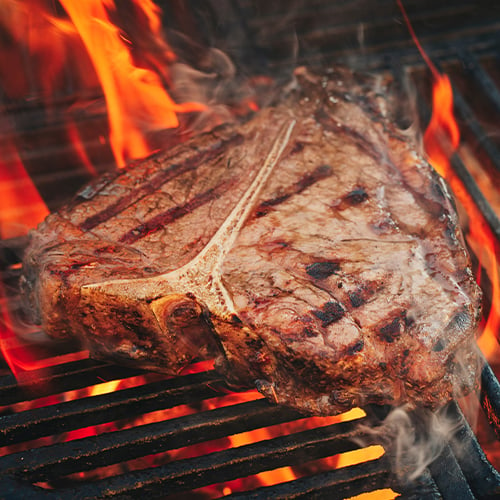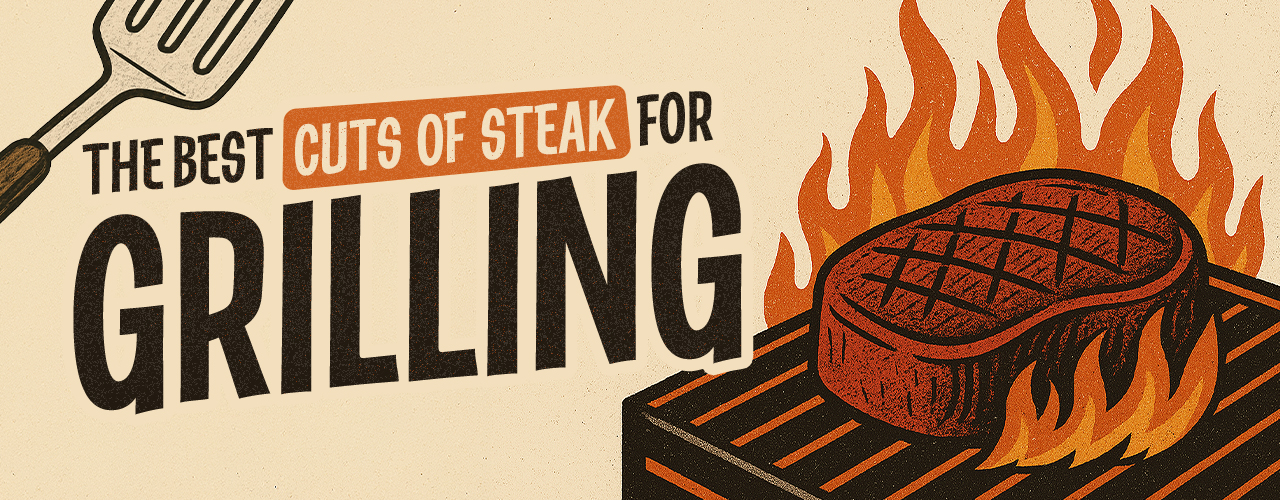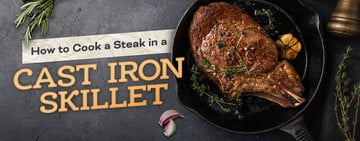Grilling a perfectly juicy steak is an art that turns heads and keeps guests coming back for more. Knowing the unique characteristics and cooking needs of different steak cuts helps refine your menu and serve consistently mouthwatering results. In this guide, we’ve highlighted the best cuts for grilling and included a handy chart to help you nail the perfect doneness every time.
Shop All Wholesale Steak1. Ribeye Steak
Ribeye is a favorite among chefs and grillmasters thanks to its generous marbling and rich, beefy flavor. Cut from the rib section, this steak has a tender, juicy texture and a high fat content that keeps it moist even over high heat. The fat renders beautifully on the grill, creating a flavorful crust that customers crave. Ribeye is ideal for high-temperature, direct grilling - just season with salt and pepper, and let the meat speak for itself. For thicker cuts, consider a reverse-sear method to ensure even cooking without over-charring the outside.

2. New York Strip
Also known as the strip loin, the New York Strip strikes a balance between tenderness and chew, offering a firm bite and a pronounced beef flavor. It’s leaner than ribeye but still has enough marbling to keep it juicy and flavorful. Its uniform shape makes it a grill-friendly option, ideal for consistent portion control and visual presentation. Strip steaks shine when cooked over medium-high heat to develop a rich sear. Avoid overcooking to preserve its natural tenderness, and let it rest properly before slicing.
3. Filet Mignon
Filet mignon, cut from the tenderloin, is prized for its buttery-soft texture and subtle flavor profile. It’s the most tender steak cut available and often commands premium pricing on menus. While it lacks the marbling of other cuts, its tenderness makes it a favorite for fine dining and upscale catering. Because it's so lean, filet mignon is best grilled quickly, just long enough to develop a rich crust without losing moisture. Its mild, tender flavor makes it the perfect canvas for a flavorful compound butter or a velvety sauce.
4. Porterhouse Steak
The porterhouse combines two premium cuts in one: the tenderloin on one side of the bone and the strip steak on the other. This large steak is ideal for sharing and a standout menu item for steakhouses and BBQ joints. Its size and dual textures offer both tenderness and bold flavor, making it a high-impact cut that grills beautifully over open flame. To ensure even cooking, it’s important to position the tenderloin side slightly away from the hottest part of the grill and to monitor internal temps carefully.

5. T-Bone Steak
Similar to the porterhouse but with a smaller tenderloin section, the T-bone delivers a comparable two-in-one steak experience. Grilling a T-bone requires the same care as a porterhouse: watch the tenderloin side to avoid overcooking. A two-zone grilling setup is ideal for controlling the doneness of each side of the steak, especially when cooking in volume.
6. Top Sirloin Steak
Top sirloin is a versatile, budget-friendly steak cut that delivers bold flavor and moderate tenderness. It’s leaner than ribeye and strip, which makes it a smart option for high-turnover operations or casual dining settings where flavor matters but margins are tight. With proper trimming and slicing, top sirloin can be just as impressive on the plate. Grill over medium-high heat, and be cautious not to overcook - it’s best served medium-rare to medium to retain moisture and texture.
7. Flat Iron Steak
Flat iron steak, cut from the chuck primal, has gained popularity in recent years thanks to its tenderness, deep flavor, and affordability. It boasts rich marbling and a uniform thickness, making it excellent for grilling. Flat iron does well with or without a marinade, but a simple marinade can amplify its flavor and tenderness, especially in large-batch or catering applications. Grill quickly over high heat and slice against the grain for optimal tenderness.
8. Flank Steak
Flank steak is a lean, flavorful cut from the abdominal muscles of the cow. It has long, visible muscle fibers and a distinct grain, which makes it ideal for marinades that help tenderize and enhance its beefy flavor. Flank steak benefits from a fast, hot sear to medium-rare doneness, and must be sliced thinly against the grain to avoid chewiness. Its wide, flat shape is excellent for grill marks and makes it perfect for sandwiches, stir fries, and plated presentations.
9. Skirt Steak
Skirt steak, often confused with flank, comes from the plate section and is even more intensely flavored. It's thinner, with more marbling and connective tissue, which gives it a slightly chewier but incredibly savory bite. Skirt steak benefits from a marinade, ideally something acidic to break down fibers and add depth, and a hot, fast grill session. Like flank, skirt should always be sliced against the grain. Due to its thinness, it’s a popular choice for fajitas, tacos, and sandwiches where flavor takes center stage.
10. Tri-Tip Steak
Tri-tip, a triangular cut from the bottom sirloin, is a West Coast BBQ favorite that’s gaining nationwide popularity. It’s known for its robust flavor, moderate marbling, and versatile size, making it perfect for slicing and sharing. Though tri-tip can be cut into individual steaks, it's most often prepared whole as a roast and sliced for service. It shines when cooked low and slow over indirect heat, then finished with a high-heat sear, or smoked first for added depth before hitting the grill. Expect a whole tri-tip roast to take about 30 to 50 minutes, depending on size and desired doneness. Let it rest well after cooking, then slice it thin against the grain. However, its grain structure changes direction, so careful slicing is key.
Steak Grilling Time and Temperature Chart
Grilling steaks starts with getting your grill hot - ideally between 450 and 550 degrees Fahrenheit for direct heat searing. Gas grills offer precise control, while charcoal provides deep, smoky flavor. For thicker steaks, use a two-zone grilling setup with a hot side and a cooler side. Sear the steak over direct heat first, then move it to indirect heat to finish cooking evenly. Below is a comprehensive steak grilling chart with grill times per side for each level of doneness, based on typical thicknesses for each steak cut.
| Steak Cut | Thickness | Rare (120-125 F) | Medium Rare (130-135 F) | Medium (140-145 F) | Medium Well (150-155 F) | Well Done (160 F) |
| Ribeye | 1 1/4"-1 1/2" | 3-4 min | 4-5 min | 5-6 min | 6-7 min | 7-8 min |
| New York Strip | 1 1/4"-1 1/2" | 3-4 min | 4-5 min | 5-6 min | 6-7 min | 7-8 min |
| Filet Mignon | 1 1/2"-2" | 3-4 min | 4-5 min | 5-6 min | 6-7 min | 7-8 min |
| Porterhouse | 1 1/2"-2" | 4-5 min | 5-6 min | 6-7 min | 7-8 min | 8-9 min |
| T-Bone | 1 1/4"-1 1/2" | 3-4 min | 4-5 min | 5-6 min | 6-7 min | 7-8 min |
| Top Sirloin | 1"-1 1/4" | 3-4 min | 4-5 min | 5-6 min | 6-7 min | 7-8 min |
| Flat Iron | 1" | 2-3 min | 3-4 min | 4-5 min | 5-6 min | 6-7 min |
| Flank | 3/4"-1" | 2-3 min | 3-4 min | 4-5 min | 5-6 min | 6-7 min |
| Skirt | 1/2-3/4" | 1-2 min | 2-3 min | 3-4 min | 4-5 min | 5-6 min |
| Tri-Tip | 1 1/2"-2 1/2" | 4-5 min + indirect heat | 5-6 min + indirect heat | 6-7 min + indirect heat | 7-8 min + indirect heat | 8-10 min + indirect heat |
Steak Grilling FAQs
We’ve answered some of the most frequently asked grilling questions to help you cook steaks with confidence and consistency.

How Long to Rest a Steak?
Resting steak for 5 to 10 minutes after grilling allows juices to redistribute, keeping the meat moist and flavorful. For larger cuts like tri-tip or porterhouse, aim for closer to 10 minutes.
How to Tell When a Steak Is Done on the Grill?
Use a probe meat thermometer by sticking it into the center of the thickest part of the steak to get the most accurate reading. Pull the steak from the grill about 5 to 10 degrees below the target internal temperature; it will continue cooking while it rests.
How Long Should You Cook a Steak on Each Side?
Most steaks need 3 to 6 minutes per side, depending on the thickness and desired doneness. Thin cuts like skirt steak require just 2 to 3 minutes per side over high heat, while thicker cuts benefit from a reverse-sear or indirect approach.
Which Steaks Benefit from a Marinade Before Cooking?
Tougher or leaner cuts like flank, skirt, and flat iron benefit most from marinating. Marinades can tenderize and enhance flavor, especially when grilling quickly over high heat.
Grilling the perfect steak takes skill and precision, especially in a foodservice setting where consistency, speed, and quality matter. By understanding the unique properties of each cut, from marbling to muscle structure, you can deliver standout dishes that satisfy every time. Whether you're serving ribeyes at a high-end steakhouse or steak tacos at a food truck, experimenting with different cuts will elevate your offerings and set your operation apart from the competition.



